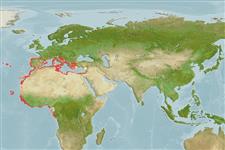>
Kurtiformes (Nurseryfishes, cardinalfishes.) >
Apogonidae (Cardinalfishes) > Apogoninae
Etymology: Apogon: Greek, a = without + Greek pogon = chin, beard (Ref. 45335).
More on author: Linnaeus.
Environment: milieu / climate zone / depth range / distribution range
ນິເວດວິທະຍາ
ສັດທະເລ ກ່ຽວກັນຫີນ; ບໍ່ມີການເຄື່ອນຍ້າຍ; ລະດັບຄວາມເລິກ 10 - 200 m (Ref. 4738). Subtropical; 45°N - 5°S, 32°W - 36°E
Eastern Atlantic and Mediterranean Sea: Portugal to Morocco and the Azores. Elsewhere, southward to Gulf of Guinea.
ຂະໜາດ / ນ້ຳໜັກ / Age
Maturity: Lm ? range ? - 5.5 cm
Max length : 15.0 cm SL ຕົວຜູ້/ບໍ່ມີເພດ; (Ref. 4738); ອາຍຸສູງສຸດທີ່ເຄຍລາຍງານມາ: 5 ປີ (Ref. 93355)
ຄີ (ໜາມ)ແຂງຢູ່ຫຼັງປາ (ທັງໝົດ) : 7; ຄີຫຼັງຂອງປາ (ຄີອ່ອນ) (ທັງໝົດ) : 9 - 10; ຄີ(ໜາມ) ແຂງຢູ່ຄີກົ້ນປາ
ກຸ່ມປາກະດູກແຂງ
ຄວາມຖີ່ຂອງກຸ່ມຖ່າຍທອດພັນ
ປາທີ່ມີການເຄື່ອນຍ້າຍຈາກທະເລໄປຫານ້ຳຈືດ ແລະນ້ຳຈືດຫາທະເລ
ປາທີ່ມີການເຄື່ອນຍ້າຍຈາກທະເລແລະໄປໄຂ່ຢູ່ນ້ຳຈືດ
ຄີກົ້ນຂອງປາ
ສັດທີ່ມີກະດູກສັນຫັຼງ
ການຖ່າຍທອດທາງກຳມະພັນຈາກພໍ່ແມ່ຫາລູກ: 2; ຄີກົ້ນຂອງປາ: 8 - 9. Eye very large, much greater than snout. Pectoral fin long, reaching at least origin of anal fin. Preopercular edge only slightly serrated, preopercular ridge smooth. Body and fins red or pink, back and upper surface of head dusky. Two or three dark spots, sometimes joined, along base of caudal fin.
Occasionally forms schools; sometimes solitary. Inhabits muddy or rocky bottoms and caves (Ref. 4738). A sciaphilous species thriving in a number of shady/dark habitats and frequents marine caves, where it forms large schools (Ref. 118281). Feeds on small invertebrates and fishes (Ref. 4738). Observed to feed in the water column and just over the bottom, always at night; 93.4% of observed events occurring outside the caves, usually on rocky bottoms and Posidonia oceanica meadows, and to a lesser extent on pebbles (Ref. 118281). Oral brooding by males (Ref. 4738).
Males incubate eggs in buccal cavity (Ref. 205, 4738, 74407). Embryos do not feed externally in the buccal cavity. Distinct pairing during courtship and spawning (Ref. 205). Internal fertilization and paternal care by mouthbrooding is found to be a rare combination of reproductive strategy (Ref. 74407). Also Ref. 240.
Tortonese, E., 1986. Apogonidae. p. 803-809. In P.J.P. Whitehead, M.-L. Bauchot, J.-C. Hureau, J. Nielsen and E. Tortonese (eds.) Fishes of the north-eastern Atlantic and the Mediterranean. UNESCO, Paris. vol. 2. (Ref. 4738)
IUCN Red List Status (Ref. 130435)
Threat to humans
Harmless
Human uses
ການປະມົງ: ເປັນສີນຄ້າ; ເຍື່ອ:
ເຄື່ອງມື
Special reports
Download XML
ແຫຼ່ງອີນເຕີເນັດ
Estimates based on models
Preferred temperature (Ref.
123201): 13.3 - 20.9, mean 16.3 °C (based on 216 cells).
Phylogenetic diversity index (Ref.
82804): PD
50 = 0.5000 [Uniqueness, from 0.5 = low to 2.0 = high].
Bayesian length-weight: a=0.01096 (0.00658 - 0.01826), b=3.11 (2.97 - 3.25), in cm total length, based on LWR estimates for this species & Genus-body shape (Ref.
93245).
ຊັ້ນເຂດຮ້ອນ (Ref.
69278): 3.4 ±0.61 se; based on food items.
Generation time: 1.2 ( na - na) years. Estimated as median ln(3)/K based on 1
growth studies.
ຄວາມຢືດຢຸ່ນ (Ref.
120179): ຂະໜາດກາງ, ປະຊາກອນຕຳ່ສຸດທີ່ໃຊ້ເວລາສອງເທົ່າ 1.4 - 4.4 ປີ (K=0.90; tmax=5).
Fishing Vulnerability (Ref.
59153): Low vulnerability (15 of 100).
Nutrients (Ref.
124155): Calcium = 56.5 [28.7, 122.3] mg/100g; Iron = 0.811 [0.475, 1.384] mg/100g; Protein = 19.7 [18.6, 20.7] %; Omega3 = 0.291 [0.167, 0.487] g/100g; Selenium = 18.6 [8.6, 36.2] μg/100g; VitaminA = 54.9 [18.0, 172.0] μg/100g; Zinc = 1.05 [0.67, 1.59] mg/100g (wet weight);
